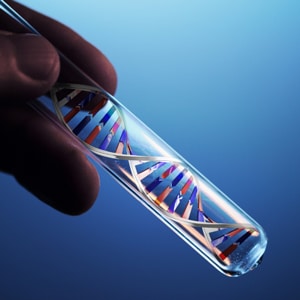
August 11, 2014
A Look At Gene Therapy
By Michael D. Shaw
It would take a few years for a brief article—published in Nature on April 25, 1953—to fully capture the public’s imagination. Its quintessentially British understated title, “A Structure For Deoxyribose Nucleic Acid,” was likely crafted by senior author Francis Crick, rather than his young American co-author James Watson.
By 1960, though, virtually every school science fair, down to the junior high level, would feature exhibits extolling the virtues of DNA, and how our new knowledge of this chemical would galvanize amazing medical breakthroughs. Many spoke of cancer cures; some mentioned reprogramming our brains to make us more intelligent; and in hushed tones, a smaller number described creating a better human race. Crick, Watson, and their associate Maurice Wilkins would share the 1962 Nobel Prize in Physiology or Medicine “for their discoveries concerning the molecular structure of nucleic acids and its significance for information transfer in living material.”
While breakthroughs have occurred, few could properly be termed “medical.” In fact, the most significant application of DNA technology to date has been in forensics, with the first DNA-based convictions happening in 1987. Mapping of the human genome was completed in April, 2003.
Most likely, DNA-inspired medical breakthroughs will come primarily from gene therapy, broadly defined as a treatment that involves altering the genes inside your body’s cells to stop disease. Two principal modes of therapy are replacing or repairing mutated genes, and making diseased cells more evident to the immune system.
In a frequently cited example, gene p53 (located on the 17th chromosome) produces a protein vital to tumor suppression. As many as 50% of all human tumors contain p53 mutants. Researchers call p53 “the guardian of the genome.” Repair or replacement of mutated p53 would surely go a long way in treating cancer. This was demonstrated in vitro in 1996, when introduction of p53 into p53-deficient cells caused rapid death of cancer cells or prevention of further division. Gene therapy, of course, would accomplish this in vivo.
As to the second mode, for various reasons, certain antigens may not be recognized by the immune system, hindering a proper response. Gene therapy could address individual components of the immune system, or even modify the antigens themselves.
Notably, not all gene therapy exists in the future. Gaucher’s disease—an enzyme deficiency causing the lipid glucosylceramide to accumulate in certain organs—has been treated since 1994 using intravenous recombinant DNA, the earliest form of gene therapy. These days, the most common method for introducing new genes is via some sort of viral vector. Viruses make their way in the world by binding to their host’s cell, penetrating the cell wall or membrane, replicating, and then escaping from the host’s cell. Thus, a near perfect gene therapy vector would be a virus, genetically altered to carry the human genes of interest.
To learn more, I spoke with Jeff Galvin, CEO of American Gene Technologies International Inc., based in Rockville, MD. His company is developing bio-safe, high efficiency lentivirus therapies to treat cancers and other chronic human diseases. Jeff’s passion for gene therapy is quite evident. He told me that treatments for hemophilia; retinitis pigmentosa; ALD (adrenoleukodystrophy—commonly known as “Lorenzo’s Oil Disease”); X-SCID (x-linked severe combined immunodeficiency “Bubble-Boy Disease”), and a variety of forms of leukemia are in the late stages of human clinical trials, and are likely to be approved.
As to his own company, Jeff elaborates: “American Gene has promising drug candidates in several solid tumor cancers—such as liver and prostate cancer. We also have advanced developments in diabetes as well as a functional cure for HIV/AIDS that would end the need for lifetime medication for patients. A rare disease that we began development on last year called Familial Dysautonomia (FD) has progressed particularly quickly.”
Jeff details the main advantages of gene therapy: “Simply put, it’s targeting and specificity. When you take a traditional drug or chemotherapeutic, it goes all over the body and can be active anywhere (and everywhere). Side effects will occur, and liver toxicity can be a problem, as well. Viral vectors, as used in gene therapy, are like tiny (the size of nanoparticles) smart bombs that are attracted to the target cells. These smart bombs also carry proximity fuses that activate the drug only in the presence of the disease.”
“We also incorporate switches inside the vector that only turn on the drug when it is near, or in the target cell. Think of these as specific promoters that turn on the therapeutic gene only in the presence of certain factors that are unique to the disease.”
I would add that gene therapy offers the promise of true cures, rather than continual treatment of symptoms—as is true with the vast majority of pharmaceutical drugs. And, in a marvelous irony, such cures would be the purest possible form of allopathic medicine, not to mention the most cost-effective.
